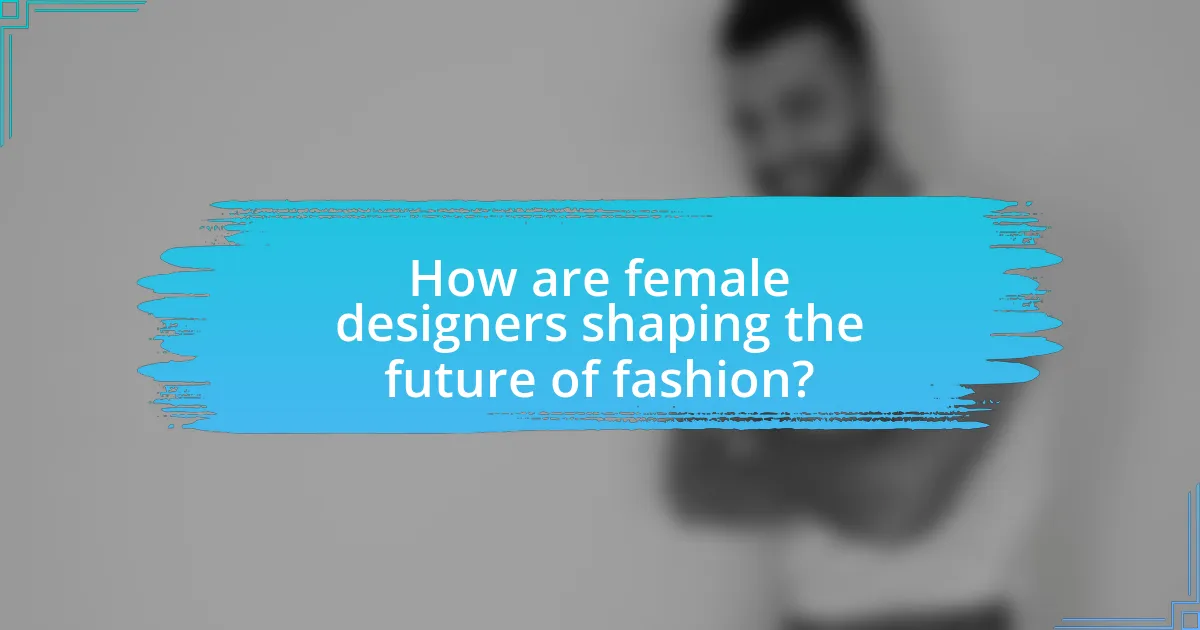The article focuses on the significant contributions of women in the fashion industry, highlighting their roles as designers, models, executives, and influencers. It examines the historical impact of trailblazing female designers such as Coco Chanel, Vivienne Westwood, and Stella McCartney, who have reshaped fashion trends, challenged traditional norms, and advocated for sustainability and inclusivity. The article also addresses the barriers women face in the industry, the importance of representation, and the emerging trends from women-led brands, emphasizing how female designers are shaping the future of fashion through innovation and technology. Additionally, it provides insights into the skills necessary for success and the value of mentorship programs for aspiring female designers.

What role do women play in the fashion industry?
Women play a crucial role in the fashion industry as designers, models, executives, and influencers. Historically, women have been at the forefront of fashion design, with notable figures such as Coco Chanel and Diane von Furstenberg revolutionizing women’s clothing and establishing iconic brands. According to a 2021 report by McKinsey & Company, women represent approximately 70% of the global fashion workforce, highlighting their significant presence in various roles, from creative direction to marketing. Furthermore, women are increasingly taking leadership positions, with a growing number of female CEOs in major fashion companies, which fosters diversity and innovation within the industry.
How have female designers influenced fashion trends?
Female designers have significantly influenced fashion trends by introducing innovative styles, challenging gender norms, and promoting inclusivity. For instance, Coco Chanel revolutionized women’s fashion in the early 20th century by popularizing the use of comfortable fabrics and the concept of casual elegance, which led to the widespread adoption of the modern women’s suit. Additionally, designers like Vivienne Westwood and Stella McCartney have pushed boundaries by integrating sustainability into their collections, reflecting a growing consumer demand for ethical fashion. The impact of female designers is evident in the way they have reshaped the industry, as seen in the rise of brands led by women that prioritize diversity and body positivity, such as Savage X Fenty by Rihanna, which has redefined lingerie marketing.
What are some iconic designs created by female designers?
Some iconic designs created by female designers include Coco Chanel’s Chanel No. 5 perfume and the classic Chanel suit, which revolutionized women’s fashion in the early 20th century. Additionally, Diane von Furstenberg’s wrap dress, introduced in 1974, became a symbol of women’s liberation and empowerment. Another significant design is the “Lady Dior” handbag, created by Gianfranco Ferré for Dior under the creative direction of Maria Grazia Chiuri, which has become a timeless luxury accessory. These designs not only showcase the creativity of female designers but also reflect cultural shifts and advancements in women’s roles in society.
How do female designers challenge traditional fashion norms?
Female designers challenge traditional fashion norms by introducing innovative designs that prioritize inclusivity, sustainability, and diverse representations. For instance, designers like Stella McCartney advocate for eco-friendly materials and ethical production practices, reshaping industry standards. Additionally, designers such as Christian Siriano emphasize body positivity by creating collections that cater to a wide range of sizes, directly opposing the conventional focus on a narrow body type. This shift not only broadens the definition of beauty but also encourages other designers to rethink their approaches, leading to a more inclusive fashion landscape.
Why is representation important in fashion design?
Representation is important in fashion design because it ensures diverse voices and perspectives are included, which leads to more innovative and relatable designs. When designers from various backgrounds contribute, they reflect the realities and identities of a broader audience, fostering inclusivity. For instance, a study by the Council of Fashion Designers of America found that brands with diverse leadership are more likely to resonate with consumers, as they create products that cater to a wider range of cultural and aesthetic preferences. This not only enhances brand loyalty but also drives sales, demonstrating that representation is not just a moral imperative but also a business advantage.
How does diversity among designers impact consumer choices?
Diversity among designers significantly influences consumer choices by fostering a broader range of perspectives and styles that resonate with diverse consumer demographics. When designers come from varied backgrounds, they create products that reflect the cultural, social, and aesthetic preferences of different groups, leading to increased consumer engagement and satisfaction. For instance, a study by the Harvard Business Review found that companies with diverse leadership teams are 35% more likely to outperform their competitors, indicating that diversity not only enhances creativity but also drives market success. This alignment between designer diversity and consumer preferences ultimately results in a more inclusive marketplace, where consumers feel represented and valued.
What barriers do women face in the fashion industry?
Women in the fashion industry face several barriers, including gender bias, lack of representation in leadership roles, and unequal pay. Gender bias manifests in hiring practices and promotional opportunities, often favoring male counterparts. According to a 2021 report by McKinsey & Company, women hold only 14% of executive positions in the fashion sector, highlighting the lack of representation. Additionally, women in fashion earn approximately 20% less than their male colleagues, as reported by the World Economic Forum in 2020. These barriers hinder women’s career advancement and perpetuate inequality within the industry.

Who are some trailblazing female designers in fashion?
Some trailblazing female designers in fashion include Coco Chanel, Vivienne Westwood, and Stella McCartney. Coco Chanel revolutionized women’s fashion in the early 20th century by introducing modernist styles and the concept of casual chic, famously popularizing the little black dress and Chanel No. 5 perfume. Vivienne Westwood is known for her role in bringing punk fashion to the mainstream and has been a significant influence on British fashion since the 1970s. Stella McCartney has made a mark with her commitment to sustainable fashion, being one of the first high-profile designers to advocate for cruelty-free practices in the industry.
What contributions have these designers made to the industry?
Trailblazing female designers have significantly transformed the fashion industry by introducing innovative designs, advocating for inclusivity, and challenging traditional gender norms. For instance, Coco Chanel revolutionized women’s fashion by popularizing the concept of casual elegance and introducing the iconic little black dress, which remains a staple today. Similarly, Diane von Furstenberg’s wrap dress empowered women by combining comfort with style, symbolizing female independence since its launch in the 1970s. Additionally, designers like Stella McCartney have led the charge in sustainable fashion, promoting eco-friendly practices and materials, which have influenced industry standards. These contributions not only reshaped fashion aesthetics but also fostered a more inclusive and sustainable industry landscape.
How did Coco Chanel revolutionize women’s fashion?
Coco Chanel revolutionized women’s fashion by introducing a more casual elegance that liberated women from the constraints of the corseted silhouette. She popularized the use of jersey fabric, which was previously used for men’s underwear, allowing for greater comfort and movement in women’s clothing. Chanel’s iconic designs, such as the Chanel No. 5 perfume and the Chanel suit, emphasized simplicity and functionality, marking a shift towards modernity in women’s attire. Her introduction of the little black dress in the 1920s transformed it into a staple of women’s wardrobes, symbolizing sophistication and versatility. Chanel’s influence is evident in her challenge to traditional gender norms, promoting a style that combined femininity with a sense of freedom, which has had a lasting impact on fashion.
What impact did Vivienne Westwood have on punk fashion?
Vivienne Westwood significantly shaped punk fashion by introducing bold designs that challenged societal norms and conventions. Her collaboration with Malcolm McLaren in the 1970s led to the creation of the iconic boutique “Sex,” which became a hub for the punk movement. Westwood’s use of unconventional materials, such as safety pins and tartan, along with her provocative graphic designs, embodied the rebellious spirit of punk. Her collections, particularly the “Pirate” collection in 1981, showcased a fusion of historical references and punk aesthetics, influencing not only fashion but also music and youth culture. Westwood’s work has been recognized for its lasting impact, as she helped to elevate punk from a subculture to a significant fashion movement, making her a pivotal figure in the history of fashion.
What are the defining characteristics of their design philosophies?
The defining characteristics of the design philosophies of trailblazing female designers in fashion include innovation, inclusivity, and sustainability. These designers often prioritize unique, boundary-pushing aesthetics that challenge traditional norms, as seen in the works of designers like Stella McCartney, who integrates eco-friendly materials into her collections. Additionally, many female designers emphasize inclusivity by creating clothing that caters to diverse body types and cultural backgrounds, exemplified by brands like Savage X Fenty, founded by Rihanna, which promotes body positivity. Sustainability is also a key focus, with designers like Gabriela Hearst advocating for ethical production practices and transparency in the fashion supply chain. These characteristics collectively reflect a shift towards a more responsible and diverse fashion industry.
How do these designers incorporate sustainability into their work?
These designers incorporate sustainability into their work by utilizing eco-friendly materials, implementing ethical production practices, and promoting circular fashion. For instance, many female designers prioritize organic fabrics, recycled materials, and low-impact dyes to reduce environmental harm. Additionally, they often collaborate with local artisans to ensure fair labor practices and minimize carbon footprints associated with transportation. Furthermore, some designers advocate for the circular economy by creating garments that can be easily repaired, reused, or recycled, thereby extending the lifecycle of their products and reducing waste. This commitment to sustainability is evident in the growing trend of brands that emphasize transparency in their supply chains and actively engage in initiatives aimed at reducing their ecological impact.
What cultural influences shape their designs?
Cultural influences that shape the designs of trailblazing female fashion designers include historical contexts, regional traditions, and social movements. For instance, designers often draw inspiration from their cultural heritage, incorporating traditional textiles and patterns that reflect their backgrounds, such as African prints or Asian silk techniques. Additionally, social movements, such as feminism and body positivity, significantly impact their design philosophies, leading to collections that promote inclusivity and challenge societal norms. This interplay of cultural elements not only enriches their work but also resonates with diverse audiences, making their designs relevant and impactful in contemporary fashion.

How are female designers shaping the future of fashion?
Female designers are shaping the future of fashion by introducing innovative designs, advocating for sustainability, and promoting inclusivity within the industry. Their unique perspectives and experiences drive creativity, leading to the emergence of new trends that challenge traditional norms. For instance, designers like Stella McCartney have pioneered sustainable fashion practices, emphasizing eco-friendly materials and ethical production methods. Additionally, female designers such as Telfar Clemens and Rihanna have expanded the definition of beauty and style, making fashion more accessible and representative of diverse identities. This shift not only influences consumer preferences but also encourages brands to adopt more inclusive practices, ultimately transforming the fashion landscape.
What trends are emerging from women-led fashion brands?
Emerging trends from women-led fashion brands include a strong focus on sustainability, inclusivity, and the use of technology in design and marketing. Women-led brands are increasingly prioritizing eco-friendly materials and ethical production practices, reflecting a growing consumer demand for sustainable fashion. For instance, brands like Reformation and Stella McCartney have set benchmarks in sustainable practices, showcasing how environmental responsibility can be integrated into fashion. Additionally, these brands are championing inclusivity by offering diverse sizing and representation in their marketing campaigns, which resonates with a broader audience. Furthermore, the integration of technology, such as virtual fitting rooms and digital fashion shows, is becoming prevalent, allowing for innovative consumer engagement and accessibility. This trend is supported by data indicating that 67% of consumers consider the use of technology in shopping experiences as important, highlighting the relevance of tech-savvy approaches in women-led fashion brands.
How are technology and innovation being utilized by female designers?
Female designers are utilizing technology and innovation to enhance creativity, streamline production processes, and engage with consumers more effectively. For instance, many female designers are adopting digital design tools like 3D modeling software, which allows for rapid prototyping and customization, thereby reducing waste and improving efficiency. Additionally, they are leveraging social media platforms and e-commerce technologies to reach wider audiences and build personal brands, exemplified by designers such as Rebecca Minkoff, who uses augmented reality in her retail spaces to create immersive shopping experiences. This integration of technology not only fosters innovation in design but also empowers female designers to challenge traditional industry norms and establish their unique identities in the fashion landscape.
What role does social media play in promoting female designers?
Social media plays a crucial role in promoting female designers by providing them with a platform to showcase their work, connect with audiences, and build their brands. This digital space allows female designers to reach a global audience without the barriers traditionally associated with the fashion industry, such as gatekeeping by established institutions. For instance, platforms like Instagram and Pinterest enable designers to share their collections, engage with followers, and collaborate with influencers, which can significantly enhance visibility and sales. According to a study by the Pew Research Center, 72% of adults use social media, making it an essential tool for marketing and networking in the fashion industry. This accessibility empowers female designers to gain recognition and establish their presence in a competitive market.
What can aspiring female designers learn from these trailblazers?
Aspiring female designers can learn resilience and innovation from trailblazing female designers who have transformed the fashion industry. These pioneers, such as Coco Chanel and Vera Wang, faced significant challenges and societal barriers yet succeeded by redefining norms and embracing their unique visions. For instance, Chanel revolutionized women’s fashion by introducing a more casual elegance that liberated women from restrictive clothing, while Wang’s designs have redefined bridal wear, emphasizing modernity and individuality. Their journeys illustrate the importance of authenticity, adaptability, and the courage to challenge the status quo, providing valuable lessons for the next generation of female designers.
What skills are essential for success in the fashion industry?
Creativity, strong communication, and business acumen are essential skills for success in the fashion industry. Creativity allows designers to innovate and create unique styles that resonate with consumers, while strong communication skills facilitate collaboration with teams and effective marketing of products. Business acumen is crucial for understanding market trends, managing finances, and making strategic decisions that drive profitability. According to a report by the Council of Fashion Designers of America, successful fashion professionals often possess a blend of artistic talent and commercial insight, underscoring the importance of these skills in navigating the competitive landscape of the industry.
How can mentorship programs support women in fashion?
Mentorship programs can support women in fashion by providing guidance, networking opportunities, and skill development tailored to the unique challenges they face in the industry. These programs often connect emerging female designers with established professionals, facilitating knowledge transfer and fostering confidence. For instance, a study by the American Association of University Women found that mentorship significantly enhances career advancement and job satisfaction for women in male-dominated fields, including fashion. By offering structured support, mentorship programs empower women to navigate the complexities of the fashion industry, ultimately leading to increased representation and innovation.
What practical steps can women take to break into the fashion industry?
Women can break into the fashion industry by gaining relevant education, building a strong portfolio, networking, and seeking internships. Pursuing a degree in fashion design or a related field equips women with essential skills and knowledge about the industry. Creating a diverse portfolio showcasing their design work and creativity is crucial, as it serves as a visual resume to attract potential employers. Networking with industry professionals through events, social media, and fashion shows can open doors to job opportunities and collaborations. Additionally, internships provide hands-on experience and valuable industry connections, often leading to full-time positions. According to the Council of Fashion Designers of America, internships are a critical step for aspiring fashion professionals, as they often lead to job offers and career advancement.

















